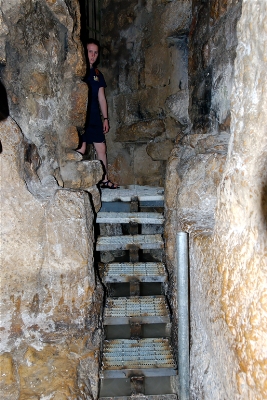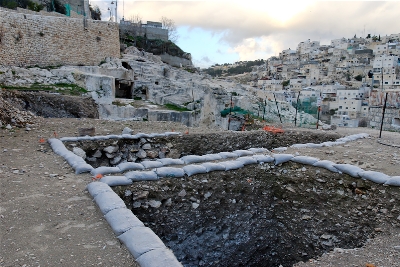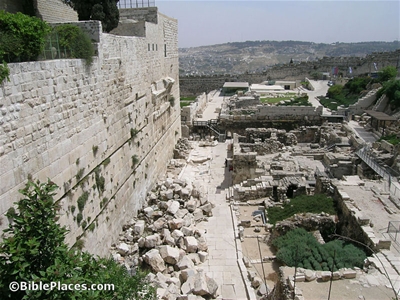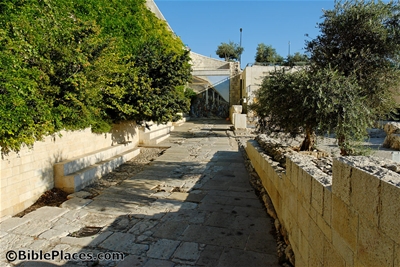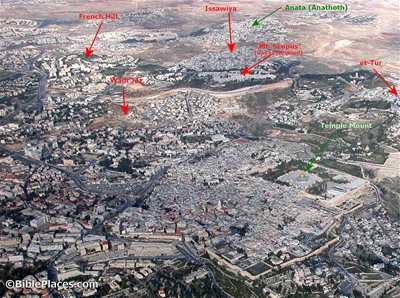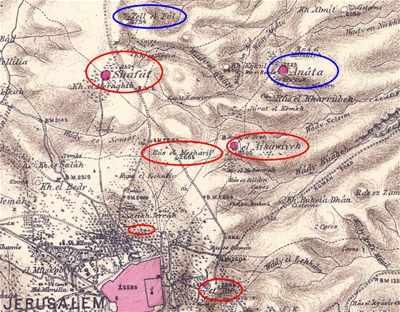Many readers may be unfamiliar with the work of the Near Eastern Archaeological Society. Founded in 1957, this group of evangelical scholars is committed to research in the lands of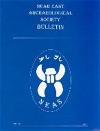 the Bible. Membership in the organization includes the annual bulletin (a journal with 4-5 articles and book reviews) as well as 4 quarterly issues of Artifax, an excellent review of the latest news throughout the biblical world. Full membership requires belief in the inerrancy and inspiration of the Bible. Supporting associates pay the same dues ($30), but need not sign the statement of faith. Student members pay half price ($15). You can get more information as well as subscription information at the NEAS website.
the Bible. Membership in the organization includes the annual bulletin (a journal with 4-5 articles and book reviews) as well as 4 quarterly issues of Artifax, an excellent review of the latest news throughout the biblical world. Full membership requires belief in the inerrancy and inspiration of the Bible. Supporting associates pay the same dues ($30), but need not sign the statement of faith. Student members pay half price ($15). You can get more information as well as subscription information at the NEAS website.
Last month, for the first time in 100 years, Hezekiah’s Tunnel was emptied of water so that repairs could be made. According to the City of David’s press release, the tunnel would be closed “for two weeks for ongoing maintenance work and restoration of the plaster on the floor of the tunnel.” Work finished earlier this week and the waters of the Gihon Spring are once again flowing through the ancient tunnel. What the press release didn’t say was that significant alterations were made to the tunnel. At the entrance of the tunnel, a large metal platform was installed in the cave where the Gihon Spring emerges. It may ease passage for old tourists, but it destroys the original look and feel.
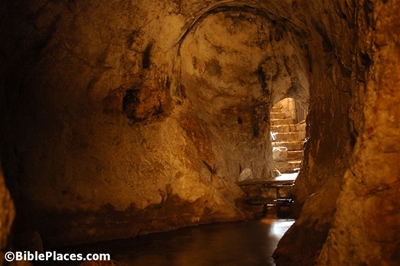
The Gihon spring cave, as it was a year ago. Today imagine a large metal platform with guard rails filling the photo.
At the end of the tunnel, metal steps were installed to make exit from the tunnel easier for people who have trouble walking. Is such modernization necessary? Do we really want 70-year-old grandmas trying to traverse the tunnel? The past is getting further away at an alarming pace. Fortunately, they have not yet installed a state-of-the-art lighting and sound system.
Forgive us for yearning for the days of Edward Robinson, the first Westerner to go through the tunnel in 1838.
Repairing one afternoon (April 27th) to Siloam, in order to measure the reservoir, we found no person there; and the water in the basin being low, we embraced this opportunity for accomplishing our purpose. Stripping off our shoes and stockings and rolling our garments above our knees, we entered with our lights and measuring tapes in our hands. The water was low, nowhere over a foot in depth, and for the most part not more than three or four inches, with hardly a perceptible current….At the end of 800 feet, it became so low, that we could advance no further without crawling on all fours, and bringing our bodies close to the water. As we were not prepared for this, we thought it better to retreat, and try again another day from the other end. Tracing therefore upon the roof with the smoke of our candles the initials of our names and the figures 800, as a mark of our progress on this side, we returned with our clothes somewhat wet and soiled” (Biblical Researches 1: 501-2).
Up the hill a bit, there are new excavations underway not far from the so-called “tomb of David.”
And, if you missed it, archaeologists last week announced the discovery of a main 1st-century street which runs from the Pool of Siloam to the Temple Mount. The Hebrew version of the article includes a photo and a diagram. The archaeologist told me a few days ago that excavation of this street is just beginning and is especially tricky because it’s all being done in a tunnel underground (reminiscent of Charles Warren’s excavations). The street is a continuation of the one visible underneath Robinson’s Arch.
- Tagged Jerusalem
Some of the artifacts from the recently closed Archaeology wing of the Israel Museum are moving around the U.S. these days. The “Cradle of Christianity” exhibit includes New Testament-related finds including a Dead Sea scroll, Caiaphas’ ossuary, Pilate inscription, menorah etching, and place of trumpeting inscription. The exhibit began its travels in Ohio, but has moved on.
Until April 15, 2007 the exhibit is in Florida at the Museum of Art, Fort Lauderdale.
From June 16 to October 14, 2007, the exhibit will be in Atlanta at the Michael C. Carlos Museum of Emory University.
Thanks to Al Sandalow for passing this on.
The Jerusalem Post reports on the finds that we speculated on before (with photos). While they certainly uncovered some new things in the dig, the article does not mention any surprising finds. In short, any archaeologist could have predicted that digging in this place would reveal:
The Valley Cardo (aka Eastern Cardo): the full 35 foot (11 m) width of the street was uncovered.
This same street was uncovered about 150 feet (50 m) to the south.
A ritual bath (mikveh) from the Second Temple period. They have found 150 of these all over the city.
A portion of the Lower Aqueduct which brought water from Solomon’s Pools to the Temple Mount.
Numerous remains of this aqueduct have been found elsewhere, including slightly to the south outside the Old City wall.
An escarpment. The article suggests that this a significant discovery, but scholars have long believed that the natural defenses of the Western Hill made it more difficult for the Romans to capture in 70 A.D. Any casual observer can see the steep drop-off as one approaches the Western Wall from the west. For a while, some believed that the Western Hill must have been fortified on its eastern side in order to explain why it took the Romans a month to conquer the area. But no evidence of a wall has ever been discovered, and Josephus, who describes the city’s fortifications at length, never mentions a wall in this area.
These remains will be preserved under a new building for the Western Wall Heritage Foundation.
This is the same organization that controls access to the tunnel excavations north of the prayer plaza.
- Tagged Discoveries, Jerusalem
The first is a brand new work, released a few months ago. The second is the 4th edition and is due out in April. I have not seen either and so can only judge them by their covers (and both fail on that count). There must be a good market for Bible atlases with so many out there; in addition to these, I am aware of two revisions underway and two new ones being written.
The IVP Atlas of Bible History, by Paul Lawrence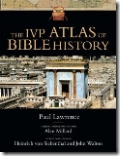
* Includes nearly 100 superb relief maps.
* Features over 140 colour photographs.
* Includes over 20 site plans and panoramic reconstructions.
* Draws on the latest finds of historians and archaeologists.
* Includes special features on topics such as the peoples and languages of the Bible throughout the text.
* Also includes a Scripture index.
This atlas is currently available for $28 from either Eisenbrauns or Amazon.
Oxford Bible Atlas, 4th ed., by Adrian Curtis
This new edition of the Oxford Bible Atlas, now with full-colour maps and illustrations, has been thoroughly revised to bring it up to date with regard both to biblical scholarship and to archaeology and topography. The Atlas will help readers of the Bible understand the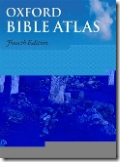 contexts in which its stories are set and to appreciate the world from which it emerged and which formed its background. Maps show the geographical setting of the Bible’s stories and reflect the successive stages of the Bible’s accounts, while specially chosen full-colour illustrations bring the countries and their peoples to life. The accompanying text describes the land of Palestine, and its wider ancient Near Eastern and east Mediterranean settin gs. It outlines clearly the successive historical periods, and describes the major civilizations with which Israelites, Jews, and early Christians came into contact. There is also an illustrated survey of the relevance of archaeology for the study of the Bible. The Atlas provides a superb guide to the geography of the Holy Land throughout biblical history, from the Exodus period through to New Testament times.
contexts in which its stories are set and to appreciate the world from which it emerged and which formed its background. Maps show the geographical setting of the Bible’s stories and reflect the successive stages of the Bible’s accounts, while specially chosen full-colour illustrations bring the countries and their peoples to life. The accompanying text describes the land of Palestine, and its wider ancient Near Eastern and east Mediterranean settin gs. It outlines clearly the successive historical periods, and describes the major civilizations with which Israelites, Jews, and early Christians came into contact. There is also an illustrated survey of the relevance of archaeology for the study of the Bible. The Atlas provides a superb guide to the geography of the Holy Land throughout biblical history, from the Exodus period through to New Testament times.
This edition will be available in April and is currently priced at $28 at Eisenbrauns and $23 at Amazon.
- Tagged Resources
Haaretz has an article that reports a new proposal by Boaz Zissu of Bar Ilan University (the Hebrew version has a small photo and map). He suggests that Nob is near a quarry that he excavated on the northern end of the Kidron Valley. The strange thing is that he comes to this conclusion based on what he did not find. He found a quarry, but no ancient settlement. He found pottery, and concludes that it must have come from somewhere nearby, and perhaps that somewhere was Nob. Perhaps.
In favor of his identification is this: his site is between Anathoth and Jerusalem, which matches the general location given in this important geographical passage:
Isaiah 10:28-32 (NIV) “They enter Aiath; they pass through Migron; they store supplies at Micmash. They go over the pass, and say, “We will camp overnight at Geba.” Ramah trembles; Gibeah of Saul flees. Cry out, O Daughter of Gallim! Listen, O Laishah! Poor Anathoth! Madmenah is in flight; the people of Gebim take cover. This day they will halt at Nob; they will shake their fist at the mount of the Daughter of Zion, at the hill of Jerusalem.” (Cf. Neh. 11:32.)
Against his identification is the fact that he found pottery from the end of the Iron Age, but an important biblical passage indicates that Nob was inhabited in the early Iron Age (1 Sam 21-22). Though not mentioned explicitly, most believe that the tabernacle was located at Nob when Saul ordered the slaughter of the priests. The absence of pottery from Iron IIa doesn’t prove that the quarry is not (near) Nob, but before an identification can be made with any certainty, such pottery must be found.
Of greater concern is the apparent methodology. I stress “apparent” because I am basing this on the newspaper article and not on the archaeologist’s proposal itself (and there may be a great gulf between the two). The problem seems to be that a site is found (or apparently found) and it is assumed to be a certain prominent place mentioned in the Bible. In fact, there are several places that this site could be, as you can see from the Isaiah passage quoted above. Scholars are reasonably certain where Anathoth is (modern Anata), and no one doubts the location of Jerusalem. But there are two other sites that are yet unidentified and this quarry could be related to either of them.
There are hundreds of unidentified tells and hundreds of sites mentioned in the Bible and other ancient texts that we cannot locate. Matching the two is not always easy, especially in a land where inscriptions are rarely preserved.
Most geographers follow Albright in locating Nob near what is known today as Mt. Scopus (Ras el-Mesharif). This is where Edward Robinson was looking as well, though his attempts to find ruins were “without the slightest success” (Biblical Researches 2:150). Aharoni suggested that Nob was just over the hill at Isawiyeh (Land of the Bible, p. 393), but Rainey thinks either Madmenah or Gebim could be Isawiyeh and Nob is el-Mesharif or further south, et-Tur (Sacred Bridge, p. 235). An important factor in these identifications is Isaiah’s mention of shaking the fist at Jerusalem, implying that the two can see each other.
Everyone agrees that the solution cannot be determined without archaeological remains from the time periods in which the site is mentioned in the historical texts.
- Tagged Discoveries
Search
About the BiblePlaces Blog
The BiblePlaces Blog provides updates and analysis of the latest in biblical archaeology, history, and geography. Unless otherwise noted, the posts are written by Todd Bolen, PhD, Professor of Biblical Studies at The Master’s University.
Subscribe
Tags
10th Century
American Colony Photos
Analysis
Antiquities Trade
Dead Sea
Dead Sea Scrolls
Discoveries
Egypt
Excavations
Forgery
Galilee
Greece
Holidays
Israel's Coast
Italy
Jerusalem
Jezreel Valley
Jordan
Jordan Rift
Judah
Lebanon
Lectures
Mediterranean Islands
Mesopotamia
Museums
Negev
New Exhibits
Persia
Philistines
Photo Resources
Picture of the Week
Pseudo-Archaeology
Resources
Sad News
Samaria
Shephelah
Syria
Technology
Temple Mount
Tomb of Jesus
Tourism
Travels
Turkey
Weather
Weekend Roundup
Links
Notice
As an Amazon Associate we earn from qualifying purchases. In any case, we will provide honest advice.
